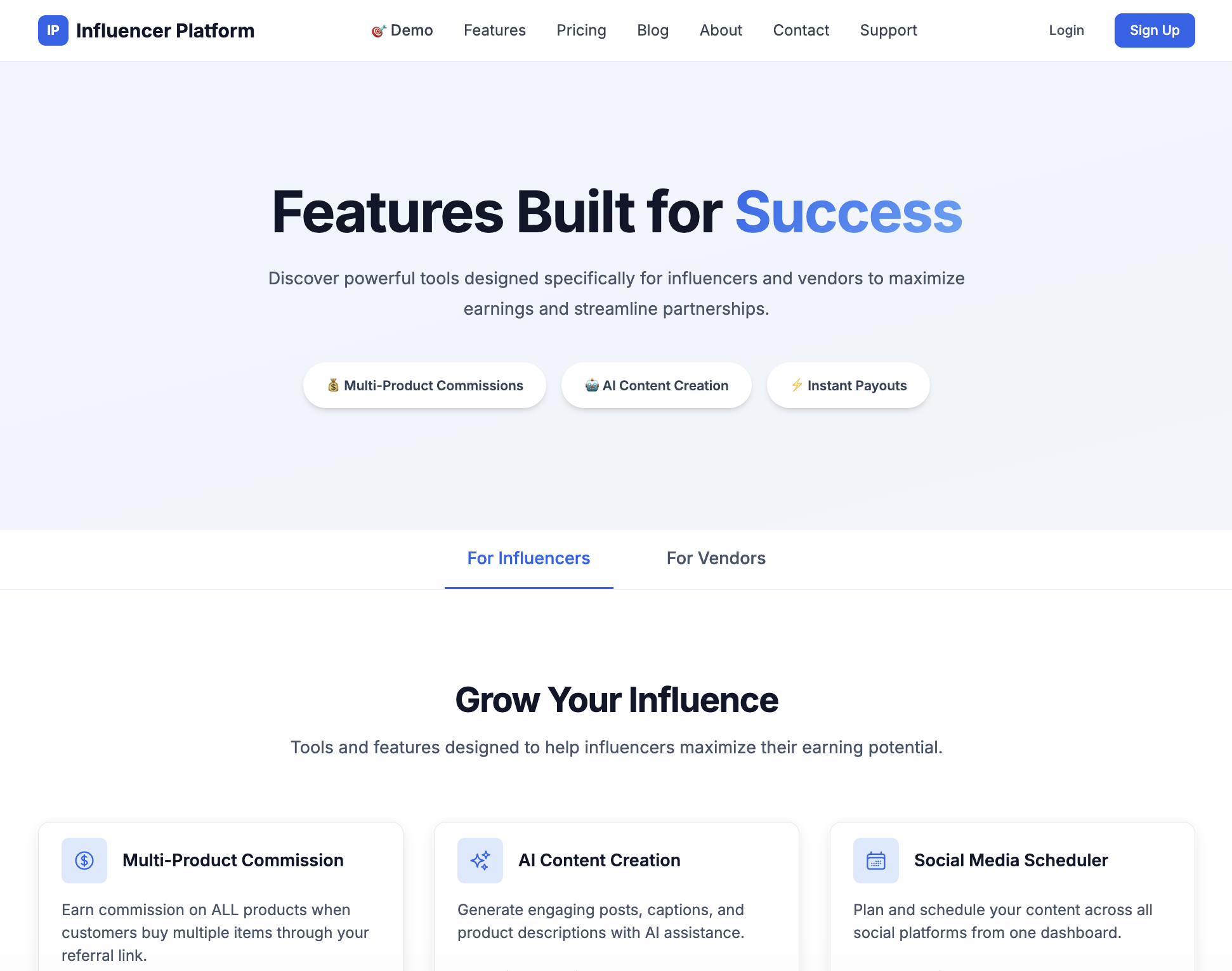
Introduction: A Market Too Big to Fail, Too Broken to Work
In 2025, the creator economy is no longer niche—it is mainstream. With over $84 billion in annual spend, and projections exceeding $110 billion by 2027, influencer marketing has cemented itself as one of the most important growth channels of the digital age. Every brand, from DTC startups to Fortune 500 giants, is allocating bigger budgets to creators. Every CMO has influencer marketing in their toolkit. Every growth leader is betting that social-driven commerce is the future.
And yet—the industry is still broken.
Marketers continue to throw billions into campaigns without being able to answer the most fundamental questions:
- Which influencers actually drive measurable ROI?
- Which product SKUs are most impacted by creator content?
- How do we scale influencer marketing with the same rigor as paid search or programmatic ads?
Today’s influencer marketing platforms—many of them unicorns themselves—were built for a world that no longer exists. They are marketplaces, not performance engines. They track surface-level metrics (impressions, likes, comments), but fail at attribution, the single most important metric in performance marketing.
This is the $50 billion black box problem—a gap so massive it represents both the industry’s greatest weakness and its greatest opportunity.
The truth is stark: traditional influencer platforms are obsolete. The next wave will not be marketplaces. They will be AI-powered attribution ecosystems with plugin-based architectures that can adapt in real time, integrating seamlessly with commerce, content, and analytics stacks.
And the startups that build this next generation? They won’t just win customers. They’ll redefine the category.
The Industry’s Structural Inefficiencies
Vanity Metrics and the ROI Mirage
The current influencer marketing stack runs on vanity metrics. Platforms still measure success in terms of impressions, follower counts, engagement rates, and “brand lift.” But VCs and CMOs alike know the uncomfortable truth: none of these directly map to sales impact.
According to a recent ANA (Association of National Advertisers) study, 73% of influencer campaigns cannot prove ROI beyond soft engagement metrics. This means tens of billions in ad spend is being justified on correlation, not causation.
Why? Because influencer marketing is built on fragmented data:
- Instagram, TikTok, and YouTube don’t expose reliable product-level sales data to third parties.
- Affiliate links and promo codes capture only a fraction of true influence, missing cross-device, multi-touch, and multi-product interactions.
- Platforms lack integration with the broader MarTech stack, making attribution impossible.
The result: marketers overspend, creators underperform (at least on paper), and platforms can’t justify their value.
Competitor Limitations
Influencer marketplaces—whether legacy players or new SaaS entrants—share common limitations:
- Search, not strategy – They help brands find influencers, but not scale ROI-positive campaigns.
- Shallow analytics – They provide engagement dashboards, but no attribution engine.
- Closed architectures – They can’t plug into evolving e-commerce ecosystems, limiting scalability.
This leaves a gaping hole: influencer marketing remains the only major channel without standardized attribution.
The Technical Challenges No One Talks About
Why hasn’t anyone solved attribution yet? Because the problem is technically brutal:
- Multi-Product Attribution – A single creator may influence sales across dozens of SKUs, often indirectly.
- Cross-Platform Tracking – Consumers engage with creators on TikTok, but convert via Instagram or Amazon.
- Real-Time Processing – Attribution models must operate at scale, ingesting massive data streams instantly.
- AI Signal Extraction – Separating true influence from noise requires machine learning models tuned for multi-touch patterns.
Most platforms weren’t built with these challenges in mind. They’re marketplaces wrapped in SaaS dashboards, not scalable attribution engines.
This is where the next generation begins.
The Attribution Problem (The $10B Opportunity)
Why 73% of Campaigns Can’t Prove ROI
Attribution is the holy grail of influencer marketing. Unlike search or programmatic ads—where clickstream data provides deterministic ROI—creator-driven conversions are messy. Consumers may:
- See a TikTok, screenshot it, and later search Amazon.
- Hear a podcast, then buy directly from a Shopify store.
- Engage with multiple creators before a single purchase.
Each scenario creates a broken chain of influence. Traditional tracking tools—UTM links, cookies, last-click attribution—simply fail. As a result, marketers underestimate impact, creators undervalue themselves, and VCs underestimate the market’s long-term scalability.
The $10B Blind Spot
Industry analysts estimate that 10–20% of all e-commerce sales are influenced by creators but not captured by attribution models. With global e-commerce expected to reach $8 trillion by 2026, that represents a $10–15 billion annual blind spot.
Whoever solves this doesn’t just fix a pain point—they unlock one of the largest untapped performance channels in the world.
What the Future Solution Needs
The breakthrough solution requires:
- Real-time multi-touch attribution engines that track across channels, devices, and products.
- AI-driven influence modeling to quantify both direct and indirect creator impact.
- Plugin architectures that integrate into existing commerce, analytics, and ad platforms.
- Transparent reporting that brands can trust and creators can monetize.
The platform that achieves this won’t just improve ROI reporting—it will redefine influencer marketing as a performance channel equal to paid search or programmatic.
The AI Revolution in Influence
Beyond Human Influencers
The rise of AI-generated influencers is not science fiction—it’s already happening. From Lil Miquela to brand-owned virtual avatars, synthetic creators are proving they can:
- Produce unlimited content at scale.
- Operate 24/7 across multiple languages.
- Avoid human unpredictability (PR scandals, missed deadlines).
AI influencers are estimated to already represent over $1 billion in annual brand spend. And this is just the beginning.
Why AI Is the Next Growth Lever
- Scalability: AI avatars can create content for hundreds of SKUs simultaneously.
- Localization: Voice synthesis + avatars = global reach without human limitations.
- Cost-efficiency: A single AI model can replace dozens of human influencers.
The next wave of influencer platforms must be built with AI-native architecture—capable of integrating human and synthetic influence seamlessly.
Proprietary AI Integration Stacks
The key is not just generating avatars, but integrating AI at every level:
- AI Attribution Models – Machine learning that distinguishes true influence from correlation.
- AI Commerce Matching – Recommender systems that pair creators with high-ROI products.
- AI Content Engines – Tools that auto-generate optimized campaign assets.
The winners in this space won’t just adopt AI—they will own the AI stack.
Platform Economics (Why Winner-Takes-All is Coming)
Technical Debt in Existing Platforms
Current influencer platforms are built on brittle architectures optimized for search, not attribution. They lack modularity, making integration slow and innovation expensive. As e-commerce platforms, social networks, and MarTech tools evolve, these platforms will fall further behind.
Why Plugin Architecture is the Future
The future belongs to plugin-based influencer ecosystems—platforms that:
- Allow brands to add/remove attribution modules.
- Integrate natively with Shopify, Amazon, TikTok, and Google Analytics.
- Scale horizontally without breaking core infrastructure.
Just as WordPress unlocked an ecosystem of plugins that created a trillion-dollar internet economy, the influencer MarTech platform of the future will be a plugin economy—flexible, scalable, and ecosystem-driven.
Winner-Takes-All Dynamics
Like Google in search or Facebook in social, influencer platforms will consolidate around performance leaders. The first to solve attribution at scale will dominate, because switching costs for brands (integrated data pipelines, campaign histories, creator relationships) will be prohibitively high.
This is a classic winner-takes-all market, and the race is just beginning.
Market Timing (Why Now)
AI Breakthroughs
- GPT-4 and beyond – enabling human-level text + video generation.
- Voice synthesis & avatars – allowing scalable global content.
- Real-time data processing – enabling attribution that was technically impossible 5 years ago.
Creator Economy Growth
- Over 200M creators worldwide as of 2025.
- Brands increasing influencer budgets by 20–30% YoY.
- Social commerce projected to reach $3 trillion by 2030.
Regulatory Shifts
- Stricter disclosure laws = more demand for transparent reporting.
- Privacy regulations (GDPR, CCPA) limit cookies, making influencer attribution more valuable.
The convergence of AI maturity, creator economy expansion, and regulatory change makes 2025–2027 the perfect window for disruption.
The Vision
Influencer marketing is not a side channel. It is the future of commerce. But without attribution, it will remain broken. The next great platform won’t be another marketplace—it will be an AI-powered attribution engine with plugin-based architecture, capable of turning influence into measurable, scalable performance.
We are building that future.
If you’re a VC who sees the opportunity in fixing one of the biggest broken channels in digital marketing, let’s talk.
- We’re selectively sharing our research with strategic partners. Don’t hesitate to reach out to me if you’d like to learn more.
